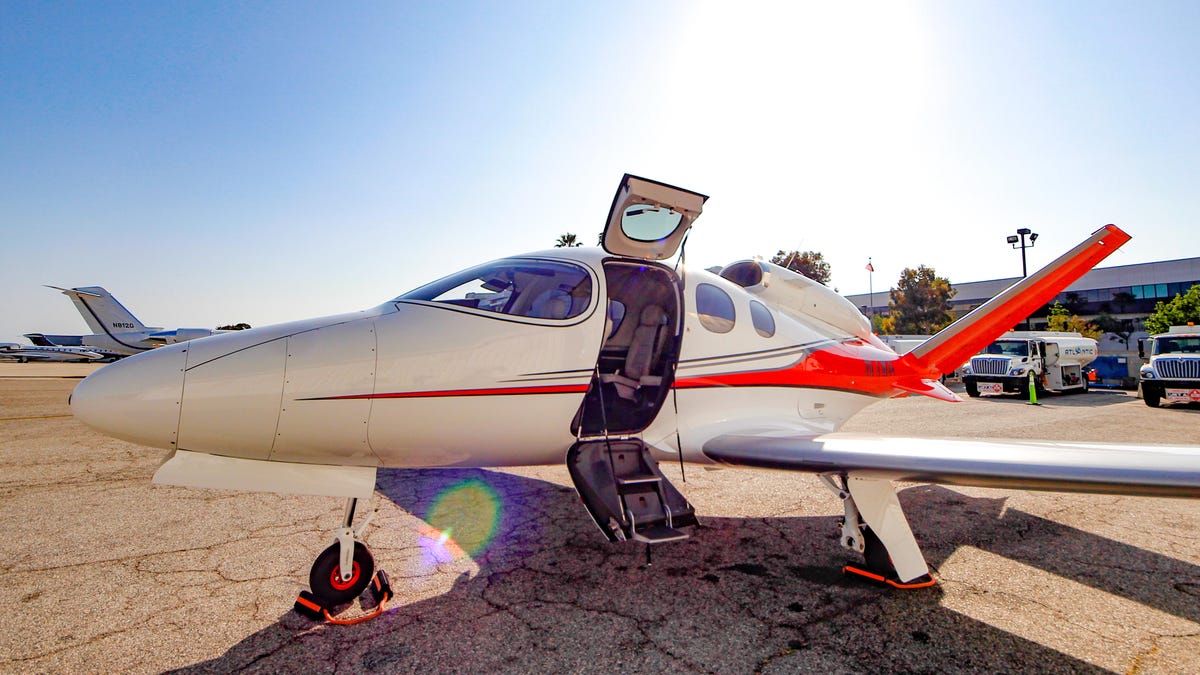 Why You Can Trust CNET
Why You Can Trust CNET Taking flight in the world’s first single-jet civil aircraft, the Cirrus Vision Jet
It seats 5-plus, flies at 345 mph, and is the first private jet ever to have just one engine. It’s the Cirrus Vision Jet. Here’s how it flies and what it looks like, inside and out.

It's odd hearing the familiar jet turbine spool-up coming from such a small aircraft. No propeller here. Not even dual jet engines hanging off the tail. No, just lovely swoops, curves and a thin backpack holding jet engine.
Say hello to the Cirrus Vision Jet, the world's first single-engine jet aircraft (outside of the military and kit planes, of course). It's a "very light jet" or "microjet" and is designed to be flown by the owner.
Supplying the get-up-and-go is a Williams International FJ33-5A, which puts out about 1,800 pounds of thrust, more than enough to propel this 3,572-pound (empty) aircraft. At its top cruising speed of 345 mph, the Vision Jet has a range of about 1,150 miles. Dial the throttle back a bit to 276 mph, and that range extends to 1,380.
Inside is leather seating for up to 5 (including the pilot), plus two smaller seats for kids. It feels more like a roomy luxury car than a small private aircraft. Since it's only 4.1 feet tall, you can't stand up, but you can move around with ease without feeling cramped. Part of that is likely due to the windows -- they're huge. Like the Boeing 787, the Vision Jet is largely carbon fiber, and that allows for larger-than-average windows. From a back seat you've got a great view outside.
Take a look in and around the Cirrus Vision Jet, the world’s first single-jet private plane
See all photosFrom the cockpit, though, it's even more incredible. The low instrument panel and tall wrap-around windshield delivers the best view from an aircraft I've ever had. The glass cockpit, which uses Garmin electronics, is easy to read and offers all the info you could want. It's also customizable with just a few taps of the screen. This is a far cry from the aging and analog Cessna 152s and 172s that constitute all the flight hours in my logbook (which has sadly not been updated since the mid-90s).
The side-stick is another drastic difference for me, though they're becoming more common in civil aircraft (modern Airbuses use them, for example). I can't claim to be able to adequately compare the Vision Jet to other small aircraft in terms of handling, but I did take a short stint at the stick and it was responsive and smooth. For some reason, my brain was expecting the light feel of a computer joystick. This was weightier, allowing for more precision and smoother movements. After a few seconds it felt very natural.
Part of the Vision Jet's smoothness is likely due to the small ruddervators under the main v-tail. Controlled by computer, they attempt to smooth out the flight.
In case of emergency: Pull red lever
On the ceiling of the cabin, between the pilot seats, is a big red lever. This activates the "CAPS", or Cirrus Airframe Parachute System. In the nose of the aircraft, behind the radar, is a parachute that can help a disabled plane descend at about 25 feet per second to land safely on the ground.
The CAPS full-plane parachute.
What I think is most clever about the Vision Jet is how laser-focused niche it is. Nearly all similarly sized propeller aircraft are 50 to 100 mph slower (with at least one notable exception). All private jets are more expensive. The Cirrus slots in right between those options, with lower maintenance costs than the jets, thanks to its single engine.
At just under $2 million, £1.57 million in the UK and AU$2.56 million in Australia, it's certainly not cheap, but it is the cheapest private jet you can buy. A little sports car for the sky, if you will.
Anyone have a spare $2 million laying around… and the 40-plus hours for my pilot's license and type rating? On second thought, Cirrus says they already have over 600 orders. Anybody want to give me another ride?
As well as covering audio and display tech, Geoff does photo tours of cool museums and locations around the world, including nuclear submarines, aircraft carriers, medieval castles, epic 10,000-mile road trips and more.
Also check out Budget Travel for Dummies, his travel book, and his bestselling sci-fi novel about city-size submarines. You can follow him on Instagram and YouTube.

